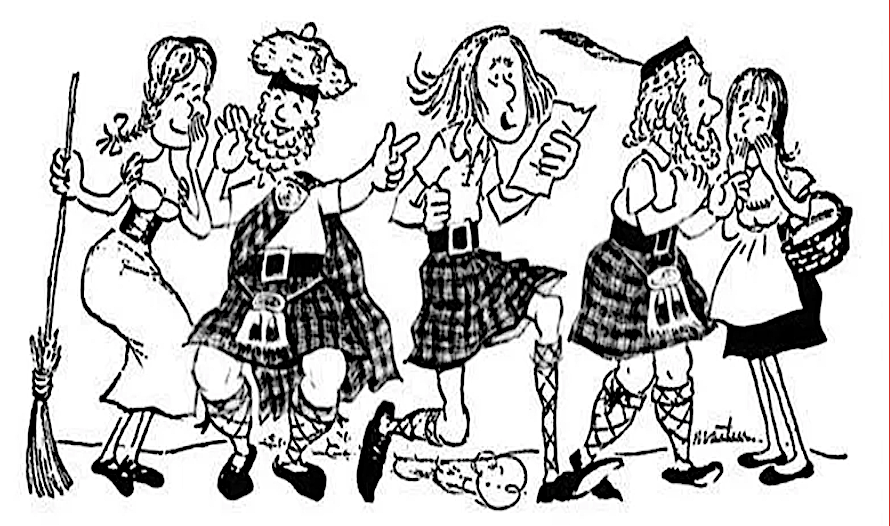




WELCOME TO An Entertainment Site for Scottish Country Dancers - Enjoy the curated selection of theme-related dances for celebrations and holidays, or find a dance associated with a special calendar day, or EVEN your own birthday!
"Hunting the Gowk" cartoon by Freeman Martin (from 1975)
Hunt the Gowk Day
Apr 1
Other Scottish Country Dances for this Day
Today's Musings, History & Folklore
"The gowk and the titlene sit on a tree...you're a gowk as well as me!"
In Scotland, where the tradition is celebrated over the course of forty-eight hours, April Fool's Day is also known as "April Gowk," "Gowkie Day" or "Hunt the Gowk." "Gowk" is Scottish for "cuckoo" (an emblem of simpletons) and thus, a "gowk" is the butt of any practical joke. The second day of the Scottish April Fool's custom is devoted exclusively to pranks involving the posterior region of the body. This is known as "Taily Day" and the origin of the ever-popular "Kick Me" sign is likely traceable to this observance. The same custom takes place in the Orkney Isles (located just off the Scottish Mainland), where this area's "Tailing Day" is also celebrated on April 2.
Hunt the Gowk
Although the origins of this widely-celebrated day remain murky, some historians claim that it began with France’s adoption of the Gregorian calendar in 1582, as determined by the 1563 Council of Trent. Not everyone caught on to -- or accepted -- the switch, and those who continued to follow the Julian calendar proceeded to celebrate the new year on or around April 1. Throughout this week, they became the butt of hoaxes and jokes. One popular prank involved pinning paper fish onto peoples’ backs and referring to them as “poisson d’avril” (literally, “April fish”), a moniker which indicated a juvenile, easily-caught fish and a gullible person.
In the 18th century, the British were introduced to this tradition, which became a full-fledged, two-day event in Scotland. The first day was dedicated to “hunting the gowk” (the word “gowk” means “cuckoo bird,” another symbol for a fool), which involved sending people on bogus errands, while the second, Tailie Day, featured hoaxes played on people’s bottoms. These included sticking fake tails or “kick me” signs on them.
A day for pranks, hoaxes, and merriment, a variation of April Fools' Day is now celebrated worldwide. From the 16th to 18th centuries, the prank that was most closely associated with April 1 was the fool's errand — also known as a wild goose chase or (archaically) a 'sleeveless errand'. This emphasis still endures, at least linguistically, in certain areas.
In Scotland April Fools’ Day is traditionally called as “Hunt-the-Gowk Day. " Gowk means cuckoo or a foolish person.
The name is believed to come from an old trick where a person is sent out with a message or variant of the following:
Dinna laugh, an' dinna smile
But hunt the gowk another mile.
The unique thing about the Scotland’s fools’ day is that unlike many other countries, Scotland celebrates it for two days i.e. on April 1st and April 2nd. On the first day people play pranks and tell lies to catch each other in an embarrassing situation. According to tradition people need to stop playing pranks and hoaxes by mid day.
For more on some old-fashioned April Fools' Day pranks from the United States, click the pictorial of April Fools' Day customs, from the Lyons Weekly Mirror – (Lyons, Iowa) Mar 24, 1877, for a whole host of good 19th century pranks.
Click the dance cribs or description below to link to a printable version of the dance!





